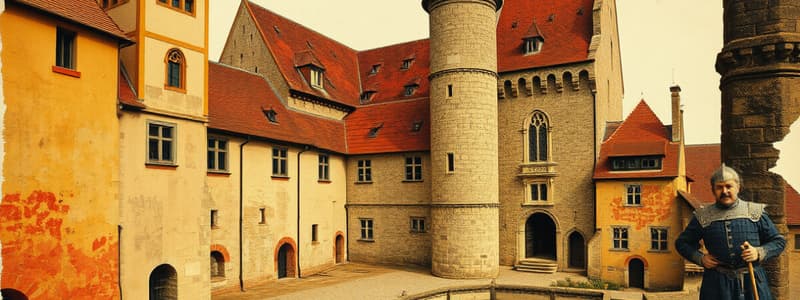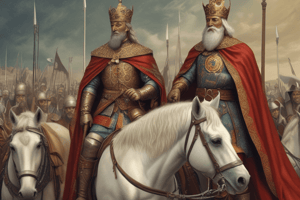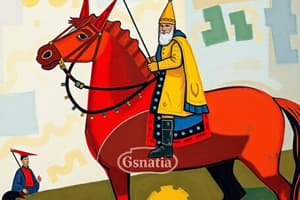Podcast
Questions and Answers
Who was Charlemagne and what was his significance in European history?
Who was Charlemagne and what was his significance in European history?
- A ruler known for developing feudalism and uniting several European regions (correct)
- An explorer who discovered new lands in the Americas
- A king who divided territories in Europe for the Pope
- A commander who fought against the Holy Roman Empire
What was the primary function of a medieval castle?
What was the primary function of a medieval castle?
- To host royal banquets and gatherings
- To serve as a center for trade
- To act as a residence exclusively for nobles
- To protect against enemies and provide safety for inhabitants (correct)
Which type of castle was characterized by its height, grand ceilings, and detailed stonework?
Which type of castle was characterized by its height, grand ceilings, and detailed stonework?
- Motte and bailey castles
- Gothic castles (correct)
- Shell keep castles
- Concentric castles
What was the manorial system in the context of feudalism?
What was the manorial system in the context of feudalism?
What were peasants required to do in exchange for living on a manor?
What were peasants required to do in exchange for living on a manor?
On which holiday was Charlemagne crowned emperor of the Holy Roman Empire?
On which holiday was Charlemagne crowned emperor of the Holy Roman Empire?
What structural feature characterized concentric castles?
What structural feature characterized concentric castles?
What composed a typical peasant diet in medieval times?
What composed a typical peasant diet in medieval times?
What was primarily used to construct peasant houses?
What was primarily used to construct peasant houses?
What responsibility did the lord of the manor have?
What responsibility did the lord of the manor have?
What was a central feature of a medieval manor?
What was a central feature of a medieval manor?
What was the primary purpose of the Crusades?
What was the primary purpose of the Crusades?
What did the Magna Carta achieve?
What did the Magna Carta achieve?
What significant development occurred with the British Parliament?
What significant development occurred with the British Parliament?
What was one reason for the prolonged conflict of the Hundred Years' War?
What was one reason for the prolonged conflict of the Hundred Years' War?
Who was a notable figure during the Hundred Years' War?
Who was a notable figure during the Hundred Years' War?
What marked the conclusion of the Hundred Years' War?
What marked the conclusion of the Hundred Years' War?
What was a significant consequence of the French and Indian War?
What was a significant consequence of the French and Indian War?
Which disease is known as the deadliest of all time, killing over 50 million people in the 14th century?
Which disease is known as the deadliest of all time, killing over 50 million people in the 14th century?
What was the main feature of the Townshend Acts?
What was the main feature of the Townshend Acts?
What was the Proclamation of 1763 designed to address?
What was the Proclamation of 1763 designed to address?
What did the phrase 'No taxation without representation' signify?
What did the phrase 'No taxation without representation' signify?
Which group was primarily allied with the French during the French and Indian War?
Which group was primarily allied with the French during the French and Indian War?
What was a primary outcome of the Battle of Castillon?
What was a primary outcome of the Battle of Castillon?
Which of the following was an immediate reaction to the heavy taxes imposed after the French and Indian War?
Which of the following was an immediate reaction to the heavy taxes imposed after the French and Indian War?
Flashcards are hidden until you start studying
Study Notes
Charlemagne and Feudalism
- Charlemagne, also known as "Charles the Great," united regions now known as France, Germany, Switzerland, the Netherlands, Belgium, and parts of Italy and Spain.
- Crowned emperor of the Holy Roman Empire by the Pope on Christmas Day, he was a pivotal figure in European history.
- Developed feudalism, where lords ruled lands under a king and citizens paid lords for protection and land use.
Castles in Medieval Europe
- Castles served as fortified structures, evolving from simple motte and bailey designs to more complex stone Gothic and concentric castles.
- Gothic castles featured tall structures with arches and detailed work, while concentric castles had layered walls for enhanced defense.
- Represents the military architecture and social structure of the Middle Ages (5th to 15th centuries).
The Manorial System
- Central to feudalism, a manor was a large estate granted by the king to a lord, serving as the local government hub.
- Peasants worked the lord's demesne for shelter and food, with a strenuous six-day workweek.
- The manor house included multiple rooms and structures, with defenses like walls and moats, reflecting the lord’s wealth.
Knights and Chivalry
- Knights, often of noble birth, participated in jousts for training and followed the strict Code of Chivalry, emphasizing honor, bravery, and respect.
The Crusades
- A series of holy wars between Christian Europeans and Islamic Arabs from roughly the 11th to 13th centuries, sparked by the Pope's call to reclaim the Holy Land.
- Only the first Crusade was deemed successful, leading to cultural exchanges that influenced Europe.
King Henry II and Thomas Becket
- Became king of England in 1154, improved the judicial system, and married Eleanor of Aquitaine, gaining French territories.
- Clashed with Thomas Becket over church vs. king’s authority, ultimately leading to Becket's death in 1170.
The Magna Carta
- Signed by King John in 1215, it limited the power of the monarchy and established rights such as trial by jury and consent for taxation.
- Influenced modern democratic principles including those in the U.S. Constitution.
British Parliament
- One of the oldest representative legislatures, evolving from an advisory meeting to a bicameral system, controlling the British government.
The Hundred Years' War
- Lasted from 1337 to 1453, fueled by competing claims to the French throne by English and French kings.
- Introduced military advancements like the longbow and cannon, significantly impacting the nature of warfare.
Joan of Arc
- A key figure during the Hundred Years' War, known for her visions that inspired French victories, ultimately captured and executed for heresy.
The Black Death
- The bubonic plague, rampant in the 14th century, led to the deaths of over 50 million people and is known as the deadliest pandemic in history.
The Seven Years' War
- Marked a shift in power in Europe, boosting British colonial influence while diminishing France’s, highlighting the economic roles of joint-stock companies.
The French and Indian War
- A conflict (1754-1763) over territory in North America that led to increased tension between Britain and its colonies, culminating in the American Revolution.
Proclamation of 1763
- Issued after the French and Indian War, aimed to stabilize relations with Native Americans and restricted colonial expansion westward, causing resentment.
The Townshend Acts
- A series of British laws imposing taxes on goods to raise revenue and assert control, sparking colonial protests and unrest.
Rising American Identity
- As tensions escalated due to taxation without representation, colonial identity began to form, unified under the motto “No taxation without representation.”
The Boston Massacre
- Occurred on March 5, 1770, when British soldiers killed five colonists during rising tensions, uniting colonial sentiment against Britain.
Crispus Attucks
- Considered the first casualty of the American Revolution, his death in the Boston Massacre symbolized resistance against British oppression.
The Boston Tea Party
- A protest organized by the Sons of Liberty in 1773 against the Tea Act, where colonists dumped British tea into Boston Harbor, escalating tensions.
The Intolerable Acts
- A response to colonial dissent, these laws closed Boston Harbor and revoked local self-government, further solidifying the path to revolution.
First Continental Congress
- Convened in September 1774 to address the Intolerable Acts, marking an important step toward collective colonial action against British rule.
Studying That Suits You
Use AI to generate personalized quizzes and flashcards to suit your learning preferences.




